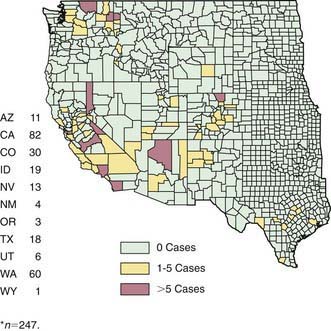Chapter 213 Relapsing Fever (Borrelia)
Epidemiology
Ornithodoros ticks, which transmit endemic relapsing fever, are distributed worldwide, including the western USA, prefer warm, humid environments and high altitudes and are found in rodent burrows, caves, and other nesting sites (Fig. 213-1). Rodents (e.g., squirrels, chipmunks) are the principal reservoirs. Infected ticks gain access to human dwellings on the rodent host. Human contact is often unnoticed because these soft ticks have a painless bite and detach immediately after a short blood meal.





